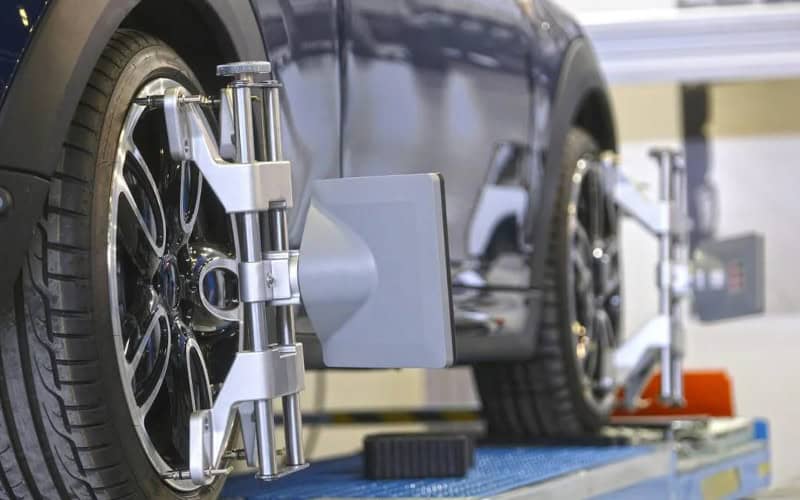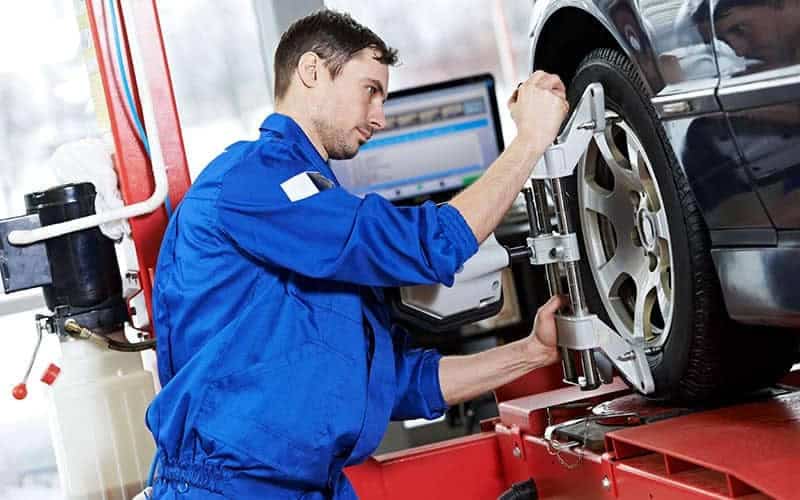Wheel Alignment & Tire Balancing in Woodbridge & Toronto GTA

Ensure Safety, Performance, and the Longevity of your Vehicle
Wheel alignment is a crucial aspect of vehicle maintenance that many drivers overlook. However, it plays a significant role in ensuring a vehicle’s safety, performance, and longevity. Proper alignment involves adjusting the angles of the wheels to manufacturer specifications, ensuring that they are parallel to each other and perpendicular to the ground. This article will explore the wheel alignment process in Woodbridge, Toronto, and the GTA, Ontario, as well as its importance and the consequences of neglecting this essential aspect of vehicle care.
The Process of Wheel Alignment
Wheel balancing is a precise process that requires specialized equipment and expertise. It involves adjusting three primary angles: camber, toe, and caster. Camber refers to the vertical tilt of the wheels when viewed from the front of the vehicle. Toe relates to the angle of the wheels when viewed from above, determining whether the wheels are pointing inward or outward. Caster is the angle of the steering pivot when viewed from the side of the vehicle.
Specialized alignment equipment, such as a laser alignment system or computerized alignment machine, is used to accurately measure and adjust these angles. The process typically involves attaching sensors to the wheels, which communicate with the alignment equipment to provide precise measurements. Based on these measurements, adjustments ensure that the wheels align according to the manufacturer’s specifications.
Significance of Wheel Alignment
Proper tire alignment is integral to maintaining vehicle safety, performance, and fuel efficiency. When the wheels are misaligned, uneven tire wear, reduced handling, and compromised stability can result. Misaligned wheels can also affect steering responsiveness, causing the vehicle to pull to one side and resulting in vibrations, especially at higher speeds, compromising the driving experience and posing safety risks.
Moreover, misaligned wheels can impact fuel efficiency by causing the vehicle to work harder to maintain a straight path, leading to increased fuel consumption. By contrast, when the wheels are properly aligned, the car experiences optimal handling, improved fuel efficiency, and reduced tire wear.
Consequences of Driving with Misaligned Wheels
Driving with misaligned wheels can harm the vehicle and its components. For instance, prolonged misalignment can lead to premature and uneven tire wear, reducing the tires’ lifespan, necessitating frequent tire replacements, and compromising the vehicle’s traction and handling, especially in winter and snow road conditions.
Furthermore, misaligned wheels can exert additional stress on the suspension system and steering components, potentially leading to premature wear and costly repairs. Neglecting 4 wheel alignment can thus result in a domino effect of detrimental consequences for the vehicle’s overall performance and longevity.
Impact on Tire Wear and Lifespan
Proper wheel alignment directly influences tire wear and longevity. When the wheels are misaligned, the tires are subjected to uneven and excessive wear patterns, manifesting as uneven tread wear on the tires, with certain areas wearing out faster than others. As a result, it can reduce the overall lifespan of the tires, necessitating premature replacements and incurring additional expenses for the vehicle owner.

Potential Signs of Misalignment
Drivers should remain vigilant for potential signs of wheel misalignment. These signs may include uneven tire wear, where certain areas of the tire tread exhibit more wear than others. Additionally, if the vehicle pulls to one side, especially when driving on a straight road, it could indicate misaligned wheels. Vibrations in the steering wheel or the vehicle’s chassis, particularly at higher speeds, may also signal the need for a car alignment check.

Benefits of Regular Wheel Alignment Maintenance
Regular wheel balance maintenance offers several benefits for vehicle owners. Firstly, it ensures optimal vehicle safety and performance by promoting even tire wear, stable handling, and responsive steering. Secondly, it improves fuel efficiency by reducing unnecessary resistance and strain on the vehicle’s components. Lastly, by extending the lifespan of the tires and minimizing the risk of premature wear, regular alignment checks can help vehicle owners save on replacement costs in the long run.
Recommended Frequency for Alignment Checks
While the frequency of wheel alignment checks may vary based on driving habits, road conditions, and vehicle type, it is generally advisable to have the alignment inspected annually or whenever any signs of misalignment become apparent. Additionally, after hitting a pothole, curb, or any significant road obstruction, it is prudent to have the alignment checked promptly to prevent potential damage and misalignment.
Addressing Misconceptions about Wheel Alignment
Common misconceptions surround tire alignment, including believing it is only necessary after a collision or major suspension repairs. In reality, everyday driving conditions and road irregularities can gradually impact wheel alignment, necessitating regular checks to maintain optimal performance and safety.
Another misconception is that wheel alignment is costly and time-consuming. However, the investment in regular alignment checks and adjustments pales compared to the potential expenses incurred from neglecting misaligned wheels, such as premature tire replacements and suspension repairs.
Wheel alignment is a critical aspect of vehicle maintenance that significantly impacts safety, performance, and cost savings for vehicle owners. By understanding the car alignment process, its importance in maintaining vehicle safety and performance, and the consequences of neglecting proper alignment, drivers can make informed decisions to prioritize regular alignment checks. By addressing potential signs of misalignment, adhering to recommended maintenance frequencies, and dispelling common misconceptions, vehicle owners can ensure that their vehicles remain in optimal condition, with properly aligned wheels contributing to enhanced safety, improved performance, and extended tire longevity. If you want to know the price, cost or how much wheel alignment is for your vehicle, contact your local Land Rover Dealer.

Advanced Suspension Repair Services for Your Land Rover
If you’re experiencing issues like a Land Rover suspension fault, our expert technicians are here to help. We specialize in air suspension repair, ensuring your vehicle maintains its legendary off-road capabilities and on-road comfort. Whether it’s an air suspension compressor malfunction or a need for a suspension calibration tool, our state-of-the-art equipment and certified technicians will diagnose and fix the problem promptly.
At Coventry North Land Rover, we understand the precision required for Land Rover’s advanced air suspension systems. From minor adjustments to complete overhauls, trust us to restore your vehicle’s optimal performance and ride quality.